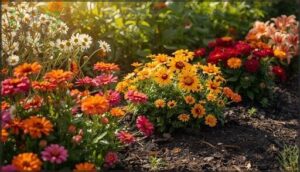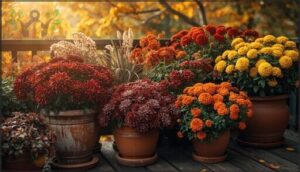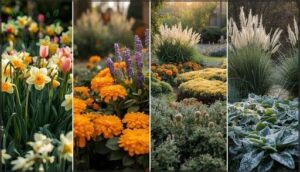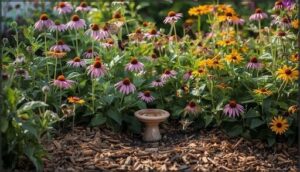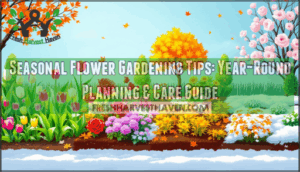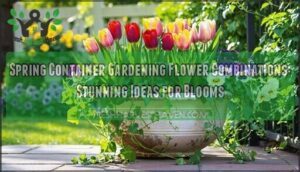This site is supported by our readers. We may earn a commission, at no cost to you, if you purchase through links.
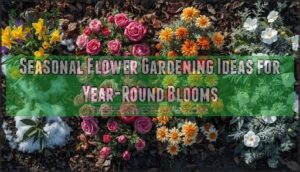
Most gardeners plant what catches their eye at the nursery in spring, which creates that boom-and-bust pattern. But when you match flowers to different seasons and layer them like a playlist, you’ll have something blooming when your neighbors’ gardens go dormant.
Here’s how to design a rotation that delivers fresh color every month without doubling your maintenance time.
Table Of Contents
- Key Takeaways
- Planning Your Seasonal Flower Garden
- Choosing Flowers for Every Season
- Designing for Continuous Blooms
- Sustainable and Wildlife-Friendly Gardening
- Maintenance Tips for Year-Round Color
- Frequently Asked Questions (FAQs)
- What is a seasonal flower garden?
- What plants are best for a fall garden?
- What makes a great blooming garden?
- What can I plant in my Spring Garden?
- What makes a good flower garden layout?
- How can I Make my Garden look better in winter?
- What is the 70/30 rule in gardening?
- What is the rule of 3 in landscaping?
- How to have a garden that blooms all year round?
- Is it okay to plant flowers in August?
- Conclusion
Key Takeaways
- You can maintain continuous garden color from early spring through late fall by strategically layering plants with different bloom times—spring bulbs like daffodils, summer perennials like black-eyed Susans, fall bloomers like chrysanthemums, and even winter-hardy pansies—instead of planting everything at once in May.
- Succession planting, where you stagger flower plantings every two weeks rather than all at once, keeps fresh blooms rotating through your beds and prevents the common boom-and-bust pattern where gardens look spectacular in early summer then fade to just green by August.
- Native and drought-tolerant plants like blanketflower and yarrow use up to 60% less water annually while attracting 40% more pollinators, making your garden both easier to maintain and more environmentally beneficial without sacrificing beauty.
- The foundation of year-round blooms isn’t more work but smarter initial planning—understanding your USDA growing zone, assessing sunlight and soil conditions, and creating a planting calendar ensures you choose flowers that naturally thrive in your specific conditions with minimal intervention.
Planning Your Seasonal Flower Garden
A successful flower garden starts with understanding what you’re working with and mapping out a realistic plan. Before you buy a single seed packet, you’ll need to evaluate your space, pinpoint your climate zone, and set up a schedule that keeps you on track.
These four planning steps will give you the foundation for blooms that last all year long.
Assessing Sunlight, Soil, and Space
Before you plant a single seed, you’ll want to get to know your garden’s personality—starting with how much sun it gets, what kind of soil it’s working with, and how much room you actually have to play with.
Spend a few days tracking sunlight patterns across your space, noting where full sun lands and where shade lingers. Test your soil’s texture and drainage, then sketch a rough garden layout that considers microclimates and helps guide smart plant selection for each spot.
Determining Your USDA Growing Zone
Once you’ve mapped out your sun and soil, it’s time to nail down your growing zone—think of it as your garden’s ZIP code for winter cold. The USDA Zone Map divides the country into 13 climate bands based on average minimum temperatures, helping you pick flowers that’ll actually survive your cold winters.
The 2023 update uses data from over 13,000 weather stations and shows zones shifting northward, so check your exact zone online. Understanding growing zones means you’ll avoid heartbreak when regional variations and microclimate impacts create pockets warmer or colder than the map suggests, and you’ll choose plants matched to future changes in your area.
These zones are based on a plant’s ability to withstand average minimum temperatures.
Creating a Planting and Maintenance Calendar
A garden calendar keeps you on track—plot your planting dates, fertilizer reminders, and deadheading schedules so you’re not scrambling when spring tulips need dividing or fall mums need pinching.
For each planting season, jot down bloom time tracking notes and weather considerations—frost dates, heat spells—so your task prioritization and resource allocation match real conditions.
Calendar customization means your garden planning is responsive to your life, turning seasonal garden care into a rhythm instead of a guessing game that garden maintenance demands.
Preparing Garden Beds and Containers
Once your calendar’s set, it’s time to roll up your sleeves and get those beds and containers ready—clearing weeds, turning soil, and setting up the right foundation makes all the difference between flowers that limp along and ones that truly thrive.
Start your soil preparation by removing grass and debris, then work in organic amendments to boost nutrients.
For container gardening, choose pots with drainage holes and use quality potting mix—your garden bed success starts with preparing the soil right.
Choosing Flowers for Every Season
Getting the timing right is half the battle when you’re aiming for nonstop color. Each season brings its own stars—spring bulbs that pop up early, summer bloomers that love the heat, fall flowers that carry you into cooler months, and even a few hardy options for winter.
Let’s walk through what to plant and when, so your garden keeps putting on a show all year long.
Best Spring Bulbs and Early Bloomers
Spring bulbs are like nature’s alarm clock, waking up your garden when everything else is still snoozing. You’ll want varieties that suit your zone’s conditions and come back reliably year after year. Daffodils lead the pack with a 98% naturalization success rate, while crocus can deliver up to 25 blooms per square foot. Hyacinths bring exceptional fragrance, and tulips offer thousands of varieties to choose from. Many gardeners find that daffodils naturalize well, returning reliably each spring.
- Daffodils and crocus return in 93% of gardens over five years with minimal care
- Alliums and bluebells boost pollinator visits by 35% in mixed plantings
- Planting depth matters: crocus at 4 inches, tulips at 8 inches for best results
Summer Annuals and Perennials
When summer heat kicks in, your garden shifts gears from delicate spring bulbs to tough, sun-loving plants that can withstand long days and hot soil. Zinnias and cosmos are heat-tolerant varieties that deliver season-long bloom with minimal fuss.
Black-eyed Susans and daylilies are summer blooming perennials that rebloom throughout the season. Mix annuals like marigolds with perennials for continuous color, and boost blooms by deadheading regularly and enriching soil with slow-release fertilizer.
Autumn Flowers for Lasting Color
As leaves start turning gold and the air gets that crisp bite, fall bloomers step up to paint your garden in warm, glowing hues that rival any autumn sunset. Chrysanthemums and dahlias deliver those rich fall color palettes—think russet, bronze, and deep burgundy. Marigolds keep pumping out frost-tolerant flowers well into October.
Try autumn planting in container gardens for movable pops of late-season blooms, and you’ll extend bloom time even as temperatures drop.
Winter-Blooming Flowers and Evergreens
Winter bloomers like amaryllis, Christmas cactus, and pansy refuse to let the cold slow them down—they bring year-round color when everything else goes dormant. Pair these winter blooms with evergreen shrubs and perennials that show off colorful bark, like red-twigged dogwoods.
You’ll need frost protection and winter maintenance (mulching, watering before freezes), but the evergreen benefits are huge: structure, wildlife shelter, and flowering shrubs that set buds for spring while looking great now.
Designing for Continuous Blooms
Keeping your garden in bloom all year takes smart planning and the right mix of plants. You’ll want to think about timing, layers, and how different plants work together to keep color coming through every season.
Here’s how to design a garden that never takes a break.
Succession Planting Techniques
Think of succession planting as your garden’s secret weapon—you’re basically staggering your flower plantings so something new is always coming into bloom just as something else is winding down.
Succession planting staggers your flower schedule so something new blooms just as another fades, keeping color flowing nonstop
Here’s how it works: instead of planting all your zinnias in May, plant some every two weeks through June. This staggered planting extends bloom times and keeps continuous color flowing through your beds all season long, creating a truly year-round display.
Layering Bulbs and Perennials
Layering bulbs under your perennials is like building a garden time machine—you’ll get waves of blooms from the same square foot of soil, starting with early-spring bulbs and moving smoothly into summer perennials above them.
Plant bulbs like tulips or daffodils deeper, then position perennials with similar soil needs above for visual harmony. As bulb foliage fades, your perennial partners emerge, creating simple succession planting that maximizes every inch of your bed.
Mixing Annuals, Perennials, and Shrubs
Building on that layered foundation, you can add flowering shrubs and a few well-chosen annuals to give your garden structure, height, and splashes of color that adapt with the seasons. Shrubs like hydrangeas offer structural diversity and reliable seasonal blooms, while annuals fill gaps quickly with year-round visual harmony.
Mix plants with similar maintenance needs—perennials anchor the design, annuals refresh it cheaply, and flowering shrubs create a backdrop that ties everything together beautifully.
Incorporating Vertical and Container Gardens
When you’re short on space—or just want to add drama to a flat garden—vertical planters and containers become your best friends. Vining plants like star jasmine climb trellises for vertical structures that soften walls, while container gardening lets you swap seasonal blooms easily.
Match container materials and maintenance needs to your schedule, creating visual interest that transforms even tiny patios into a thriving flower garden year-round with smart space optimization and aesthetic blending.
Sustainable and Wildlife-Friendly Gardening
You can grow a gorgeous garden and do right by the planet at the same time. When you choose native plants, mulch organically, and welcome pollinators, you’re creating a space that thrives with less work and more life.
Let’s look at four ways to make your flower garden both sustainable and wildlife-friendly.
Selecting Native and Drought-Tolerant Flowers
You’ll want to choose native plants and drought-resistant perennials that thrive year-round with less water. Native species like blanketflower, rudbeckia, and yarrow use up to 60% less water annually while boosting pollinator visits by 40%.
These seasonal flowers adapt beautifully to climate challenges, cut your water bill by around $46 yearly, and support local bees and butterflies even during dry spells.
Organic Mulching and Composting Tips
Once you’ve picked the right plants, a good layer of organic mulch can slash your watering needs by 70% while feeding your soil naturally.
Here’s how to make the most of it:
- Choose the right mulch types – shredded bark, straw, or leaf mold work beautifully
- Add compost starters like kitchen scraps or grass clippings to enrich soil
- Apply 2–3 inches around flowers for water retention and weed control
- Skip synthetic fertilizer – organic material feeds plants slowly and safely
- Refresh annually to maintain soil enrichment and suppress weeds effectively
Creating Pollinator Habitats
By designing your garden to welcome pollinators, you’re joining urban hotspots like Phoenix and Santa Fe in supporting ecosystem health. Native plants like coneflowers and sunflowers attract pollinators while delivering economic benefits—insect pollination adds over $34 billion to U.S. agriculture annually.
Even small habitat types, like container gardens, boost garden biodiversity and help 75% of flowering plants thrive through wildlife partnerships.
Waterwise and Climate-Resilient Practices
Smart watering habits aren’t just good for your wallet—they’re your garden’s best defense against unpredictable weather and longer dry spells. Here’s how to build climate-resilient flower beds:
- Choose drought-tolerant flowers and native species that naturally thrive in your region’s rainfall patterns
- Apply organic mulch 2-3 inches deep to boost soil health and cut water evaporation by 70%
- Set up rainwater harvesting systems to capture free irrigation for your waterwise garden
These sustainable gardening practices support wildlife while protecting your blooms.
Maintenance Tips for Year-Round Color
Keeping your garden vibrant all year takes some ongoing care, but it’s easier than you might think. A few simple maintenance habits make a huge difference in how your flowers perform through every season.
Here’s what you need to focus on to keep those blooms coming strong.
Deadheading, Pruning, and Fertilizing
Think of deadheading, pruning, and fertilizing as your garden’s personal maintenance crew—each one plays an essential role in keeping your flowers blooming strong from spring through fall. Deadheading removes spent blooms and redirects energy into fresh flowers. Pruning techniques shape plants and encourage healthy growth.
Apply a slow-release fertilizer liberally throughout the season, adjusting based on your plants’ needs. Keep your tools clean and sharp for better plant care and easier garden maintenance.
Protecting Against Frost and Heat
Your flowers face two opposite enemies—spring’s sneaky late frosts and summer’s relentless heat—but protecting them doesn’t require fancy equipment or a degree in meteorology.
For frost protection, drape row covers or old sheets over tender plants when temperatures dip, and apply a thick layer of mulch around roots.
When heat stress strikes, water deeply in early morning and use organic mulch to reduce soil evaporation by up to 70%.
Smart plant selection and these watering strategies keep blooms thriving through temperature swings, extending the blooming season naturally.
Managing Pests Naturally
Pests don’t need pesticides to get the message—they just need a garden that’s stacked in favor of the good guys. Build soil health with compost, attract beneficial insects like ladybugs and lacewings, and try companion planting to confuse pests naturally.
When pest identification confirms trouble, use natural sprays sparingly—your pollinators will thank you, and your garden pest control stays chemical-free.
Seasonal Cleanup and Garden Care
A garden that’s blooming strong all year still needs a little seasonal TLC to keep the show running smoothly. Fall leaf removal prevents disease, while winter protection strategies shield tender plants. Spring soil prep refreshes beds, and summer weed control keeps invaders at bay.
Don’t skip seasonal tool maintenance—clean pruners and sharp spades make garden maintenance easier. Pair smart watering with natural pest control, and you’ll sail through every season.
Frequently Asked Questions (FAQs)
What is a seasonal flower garden?
Seasonal flower gardening rotates bloom types through the year to maintain garden aesthetics and year-round interest. By selecting flowers with varied bloom seasonality—spring bulbs, summer perennials, autumn chrysanthemums, and winter pansies—you’ll enjoy continuous color despite regional variations in growing conditions.
What plants are best for a fall garden?
Chrysanthemums deliver stunning fall bloom colors in gold, rust, and burgundy.
Dahlias provide late-season interest alongside marigolds and asters.
Cold-hardy flowers like pansies and violas extend autumn planting well into cooler weeks, brightening your seasonal garden design.
What makes a great blooming garden?
Like a tapestry where every thread matters, bloom diversity creates visual harmony through layering colors, heights, and textures.
Add fragrance, low-maintenance choices, and pest resistance for season-long beauty with minimal fuss.
What can I plant in my Spring Garden?
Spring blooms arrive with cheerful tulips and daffodils, fragrant hyacinths, and early bloomers like crocus. For spring container ideas, try layering bulbs with cool-season pansies.
Your flower garden thrives when planting mirrors spring color schemes—soft pinks, sunny yellows, vibrant purples—weaving continuous blooming magic.
What makes a good flower garden layout?
Ever notice how the most stunning gardens feel natural? Color harmony, height variation, and texture contrast create that magic.
Strong focal points anchor your garden design, while thoughtful plant groupings and garden style choices transform spaces into living art through visual interest.
How can I Make my Garden look better in winter?
Don’t let winter mean bare beds. Evergreen shrubs and ornamental grasses give your garden structure, while winter-blooming plants like violas and pansies add cheerful color even through frost.
What is the 70/30 rule in gardening?
Sometimes less creates more—that’s the beauty of the 70/30 rule in garden design. Allocate 70% of your flower garden to one dominant plant type for visual impact, then fill 30% with contrasting colors or textures.
This design principle balances resource allocation while creating stunning visual interest without overwhelming your garden layout.
What is the rule of 3 in landscaping?
The rule of 3 in landscape design suggests grouping plants in odd numbers—especially threes—to create visual balance and natural focal points.
This technique adds visual interest to your garden layout, making groupings feel more organic and eye-catching than even-numbered arrangements.
How to have a garden that blooms all year round?
Want year-round garden blooms? Master bloom succession by layering bulbs, perennials, and annuals with staggered bloom times.
This approach creates season-long color balance while maintaining garden structure and visual interest throughout extended seasons.
Is it okay to plant flowers in August?
August planting works great for fall bloomers and cool-season annuals. Choose heat-tolerant varieties, prep your soil with compost, and water consistently.
Late-season blooms like mums and pansies thrive when planted now, extending your gardening calendar beautifully.
Conclusion
Here’s the irony: most gardeners think year-round color means year-round work. But seasonal flower gardening ideas actually simplify your schedule—once you’ve layered the right plants, nature takes care of the rotations while you enjoy the show.
Your garden becomes less about constant replanting and more about watching each season unfold on cue. That three-month vacation you thought was inevitable? It just turned into a permanent residency of blooms that know exactly when to clock in.
- https://www.gardencentermag.com/news/gardening-trends-2025-economic-uncertainty-garden-media-group-spring-analysis/
- https://www.kruckeberg.org/climate/
- https://thursd.com/articles/wildflower-gardens-health-environment-biodiversity-benefits
- https://extension.umd.edu/resource/sustainable-gardening-solutions-climate-change
- https://www.marthastewart.com/eco-friendly-gardening-trends-2025-philadelphia-flower-show-11694493


